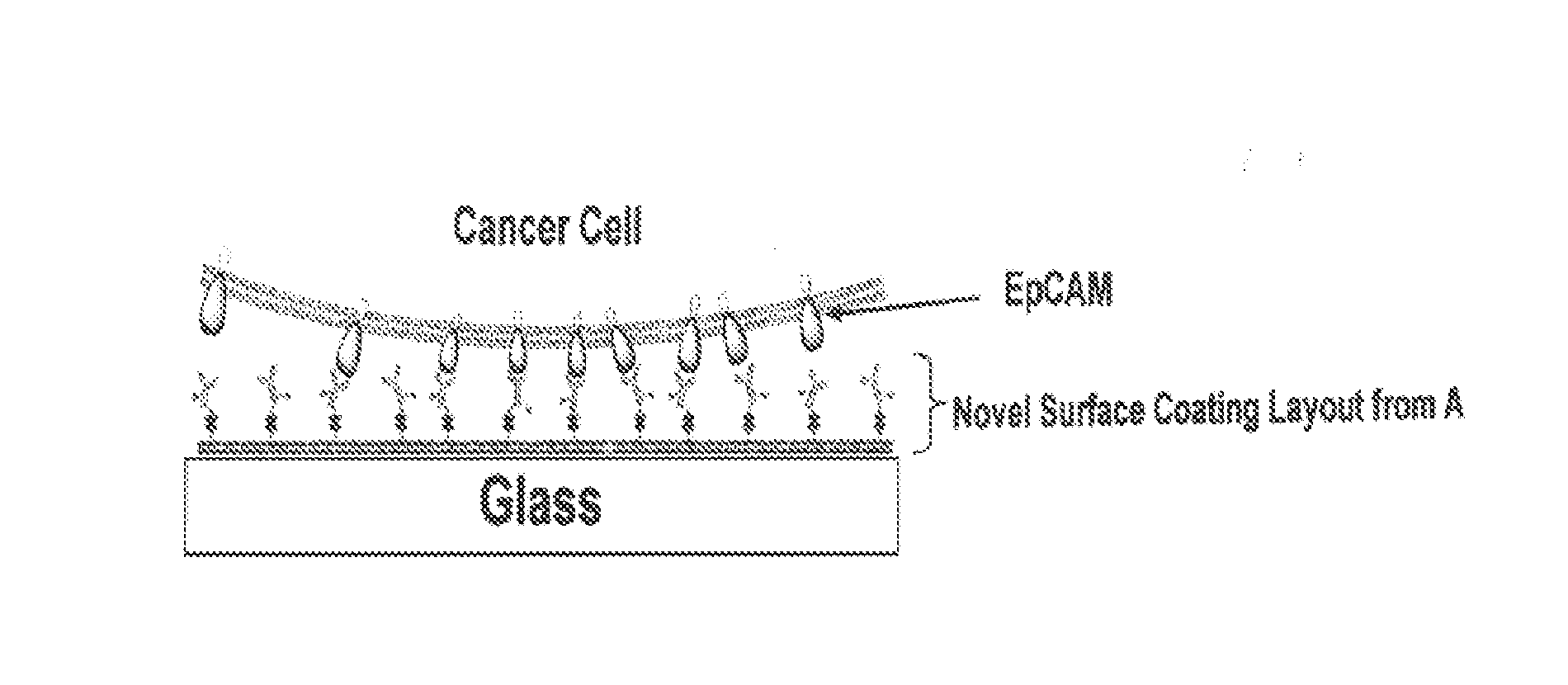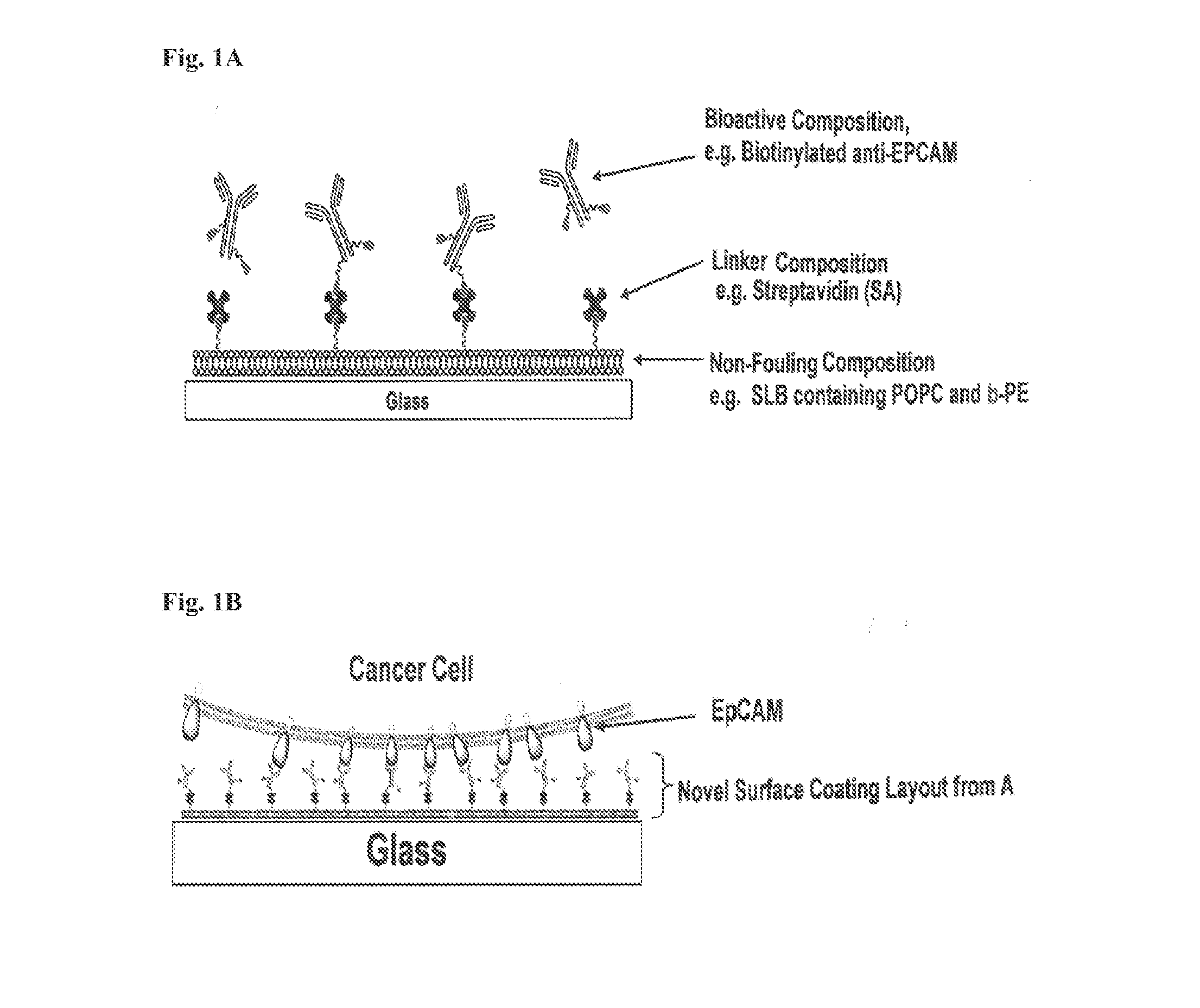Capture, purification, and release of biological substances using a surface coating
a surface coating and biological substance technology, applied in the field of capture, purification, and release of biological substances, can solve the problems of low detection rate of pure ctcs and difficult detection of ctcs, and achieve the effect of reducing the binding of non-specific cells or protein adsorption and increasing the capture efficiency of cr
- Summary
- Abstract
- Description
- Claims
- Application Information
AI Technical Summary
Benefits of technology
Problems solved by technology
Method used
Image
Examples
example 1
Preparation of the Two-Layer Surface Coating
Preparation of the Nonfouling Composition:
[0103]Supported lipid bilayer (SLB) was prepared by the following steps:[0104](1) POPC and b-PE (commercially available from Avanti Polar Lipids, USA) were dissolved in chloroform and the final lipid concentration was 5 mg / mL. The POPCb-PE solution was vortex dried under a slow stream of nitrogen to form a thin, uniform POPCb-PE film. The POPCb-PE film was further dried in a vacuum chamber overnight to remove residual chloroform.[0105](2) The POPC / biotin-PE film in step (1) was dispersed in and mixed with a phosphate buffer containing 10 mM of phosphate buffered saline, 150 mM of sodium chloride aqueous solution, and 0.02% (w / v) of sodium azide (NaN3, commercially available from Sigma-Aldrich, USA), with the pH adjusted to 7.2. The mixed solution was filtered through the 100-nm, followed by the 50-nm Nuclepore® track-etched polycarbonate membranes (Whatman Schleicher & Schuell, Germany) at least 10...
example 2
Preparation of the Microfluidic Chip
[0125]The microfluidic chip can be prepared by the following steps:[0126]1. A commercial CO2 laser scriber (Helix 24, Epilog, USA) was used to engrave the microtrenches to form microstructures on the PMMA substrate.[0127]2. The PMMA substrate, glass substrate and nuts were cleaned MeOH, detergent and water, followed by 10 min sonication. The nuts and the solid substrates were dried by nitrogen gas and baked for 10 min at 60° C.[0128]3. The PMMA substrate s bonded with nuts by chloroform treatment.[0129]4. PMMA substrate and the glass slide were joined together using an adhesive (e.g. 3M doubled sided tape from 3M, USA).
example 3
CTCs Binding to the Anti-EpCAM Functionalized SLB Surface Coating
[0130]Eight blood samples were used to determine the CTC capture rate of the Anti-EpCAM functionalized SLB surface coating in a microfluidic chip in Example 2. Each blood sample contained 2 ml of blood from a stage IV colon cancer patient and the sample was introduced to the sealed channel of the microfluidic chip at 0.5 ml / hr, controlled by a syringe pump. Subsequently, the sealed channel in the microfluidic chip was rinsed with 0.5 ml of PBS buffer at the flow rate of 1 ml / hr, followed by in situ immunostaining.
[0131]The number of CTCs captured per ml of blood for these 8 samples were 26, 34 39, 47, 67 79, and 99. 25% of the blood samples had 79 or higher CTC count per ml of testing sample and the median CTC count was 43 per nil of testing sample. There was minimal binding of the non-specific cells and proteins after the buffer rinse.
[0132]As a comparison, the CTC count for the FDA approved Veridex CellSearch is as f...
PUM
| Property | Measurement | Unit |
|---|---|---|
| Fraction | aaaaa | aaaaa |
| Thickness | aaaaa | aaaaa |
| Thickness | aaaaa | aaaaa |
Abstract
Description
Claims
Application Information
 Login to View More
Login to View More - R&D
- Intellectual Property
- Life Sciences
- Materials
- Tech Scout
- Unparalleled Data Quality
- Higher Quality Content
- 60% Fewer Hallucinations
Browse by: Latest US Patents, China's latest patents, Technical Efficacy Thesaurus, Application Domain, Technology Topic, Popular Technical Reports.
© 2025 PatSnap. All rights reserved.Legal|Privacy policy|Modern Slavery Act Transparency Statement|Sitemap|About US| Contact US: help@patsnap.com



